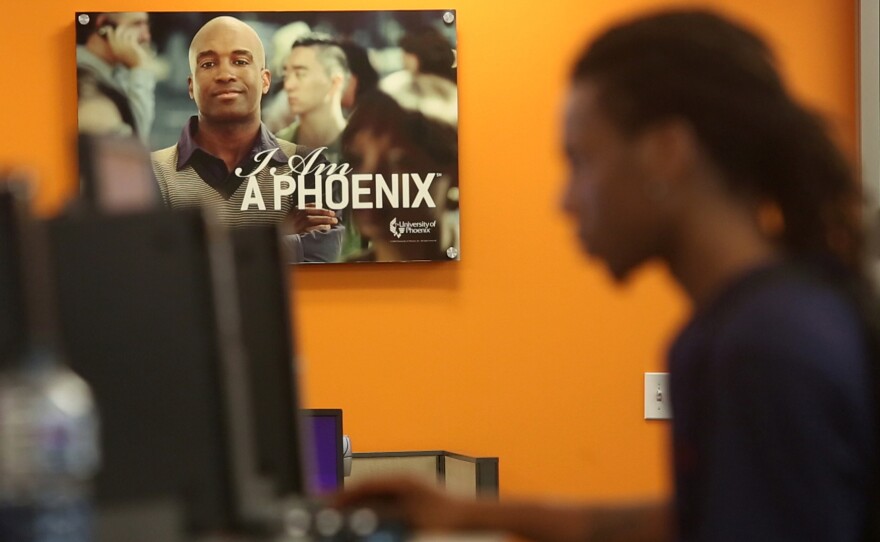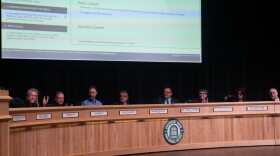
Over the past five years, more than $600 million in college assistance for Iraq and Afghanistan veterans has been spent on California schools so substandard that they have failed to qualify for state financial aid.
As a result, the GI Bill — designed to help veterans live the American dream — is supporting for-profit companies that spend lavishly on marketing but can leave veterans with worthless degrees and few job prospects, The Center for Investigative Reporting found.
“It’s not education. I think it’s just greed,” said David Pace, a 20-year Navy veteran who used the GI Bill to obtain a business degree from the University of Phoenix’s San Diego campus.
Although taxpayers spent an estimated $50,000 on Pace’s education, he has the same blue-collar job he landed right after he left the service: running electrical cable for a defense contractor.
Financial records analyzed by CIR show that California is the national epicenter of this problem, with nearly two out of every three GI Bill dollars going to for-profit colleges.
The University of Phoenix in San Diego outdistances its peers. Since 2009, the campus has received $95 million in GI Bill funds. That’s more than any brick-and-mortar campus in America, more than the entire 10-campus University of California system and all UC extension programs combined.
For the University of Phoenix, this is a sign of success.
“Veterans choose the University of Phoenix,” said Garland Williams, its vice president for military affairs. “The programs we offer are the ones that they desire and lead to careers that they want to aspire to.”
The school’s large share of GI Bill funding reflects more than just the number of veterans enrolling. The programs are expensive. An associate degree costs $395 a credit, for instance — nearly 10 times the cost at a public community college.
The University of Phoenix won’t say how many of its veterans graduate or find jobs, but the overall graduation rate at its San Diego campus is less than 15 percent, according to the U.S. Department of Education, and more than a quarter of students default on their loans within three years of leaving school.
Those figures fall short of the minimum standards set by the California Student Aid Commission, which dispenses state financial aid. The commission considers a graduation rate lower than 30 percent or a loan default rate of more than 15.5 percent as clear indicators of a substandard education.
No such restrictions govern GI Bill funds. And nearly 300 California schools that received GI Bill money either were barred from receiving state financial aid at least once in the past four years or operated without accreditation, CIR has found.
Of the $1.5 billion in GI Bill funds spent on tuition and fees in California since 2009, CIR found that more than 40 percent — $638 million — went to schools that have failed the state financial aid standard at least once in the past four years.
Four of those schools were University of Phoenix campuses, which together took in $225 million.
Among the others are massage schools, paralegal programs and auto repair academies. More than a third — 121 schools — have no academic accreditation, like the Institute for Advanced Study of Human Sexuality in San Francisco and the Pacific Coast Horseshoeing School in Amador County.
This is not what advocates hoped for when they pushed a new GI Bill through Congress in 2008. With its approval, the government for the first time since World War II committed to funding the full cost of a college education for veterans — pegged to the price tag for in-state tuition at the most costly public universities, up to $19,000 a year.
The advocacy group Iraq and Afghanistan Veterans of America pushed hard for the bill’s passage. The results have been disappointing, said Kate O’Gorman, the organization’s political director.
“Enormous amounts of GI Bill dollars” are going to schools that don’t see veterans as the future of the country, O’Gorman said. Instead, companies are “seeing the benefit dollars they can line their pockets with.”
Education At The University Of Phoenix
Nationally, the University of Phoenix received nearly $1 billion from the new GI Bill over the past five years. In all, 80,000 veterans from America’s recent wars spent their GI Bill money at 89 of its campuses and its online college, Department of Veterans Affairs data shows.
But it’s impossible to tell whether those veterans are receiving a quality education. In fact, no one from any state or federal government knows whether veterans who go to school on the GI Bill graduate or find jobs.
The University of Phoenix’s San Diego campus doesn’t look like a college. It’s a few mid-rise office buildings in a suburban office park, indistinguishable from the life insurance company that occupies the glass-and-steel structure across the street.
Like all of the other campuses in this for-profit college chain, the buildings here are leased, not owned, so the company can quickly respond to changing market conditions. Faculty members are just as temporary. No instructor has tenure. The vast majority of them are part time.
On a Friday morning in early May, a team of inspectors from the California VA pulled into the parking lot and headed to a conference room, where the college’s staff had laid out piles of student veterans’ transcripts and financial records.
The audit’s purpose was to ensure that GI Bill money was properly spent, but auditors don’t sit in on classes or review the qualifications of instructors. “That’s not a part of the visit at all,” said Latanaya Johnson, one of the agency’s senior inspectors.
Auditors look exclusively at paperwork, Johnson said, to make sure schools aren’t billing the government for students who don’t exist. No one from the state or federal government is checking to see if the education taxpayers are paying for is helping veterans find jobs.
The day before the auditors arrived, Kelly Price Noble taught a graduate course to 17 students, 15 of them veterans. Although the course was on human resources management, Noble spent much of the three-hour session providing tips on how to get a job, rather than how to manage employees.
Don’t talk about your children during a job interview, she advised. “To me, as an employer, that means that you don’t want to work overtime or on the weekend. Talk about that after you get hired.”
One of Noble’s students, Joe Ellis, spent 24 years in the Army, serving in Desert Storm, Iraq and Afghanistan. He finished his bachelor’s degree at the University of Phoenix and returned for his master’s while programming fighter jets for a military contractor. He enjoys the camaraderie of learning alongside other veterans.
“You’d be surprised how many guys work for me now that are afraid of computers or dealing with people, and I won’t see that with the guys I … go to school with, because they’re all open,” said Ellis, 49. “The new exposures, the new programs, new people and we realize we’re all the same.”
Yet the University of Phoenix is under fire from its accrediting agency. In a public disclosure in October, the Higher Learning Commission said the school failed to show that its “learning resources support student learning and effective teaching.” The commission also found that it didn’t demonstrate “that acquisition of a breadth of knowledge and skills and the exercise of intellectual inquiry are integral to its educational programs.”
Williams, the University of Phoenix vice president, downplayed the severity of the sanction, noting that the school was given a year to present a correction plan. But he wouldn’t detail specific failures that led to the sanction, and as a private company the university is exempt from public records laws.
“As a university, we have chosen, for various reasons, things that we’re going to disclose,” Williams said.
Officials from the California VA twice have written to the University of Phoenix asking for a complete copy of the accrediting body’s findings, to no avail.
“It concerns us that some schools don’t feel any obligation to provide us with details that are essential for us to establish whether they are effectively serving veterans or not,” said Keith Boylan, the state’s deputy secretary for veterans services.


Efforts To Change GI Bill Blocked
Lawmakers in Washington are well aware that GI Bill money is being wasted. In 2012, Iowa Sen. Tom Harkin, a Democrat and chairman of the Senate Committee on Health, Education, Labor and Pensions, issued a scathing 5,000-page report detailing the practices of 30 large for-profit education firms.
But when Harkin and his colleagues try to solve the problem, they run into a wall of opposition from the for-profit industry.
Among the failed legislation: a bill that would have blocked schools with no academic accreditation from receiving GI Bill money. Another bill, which would have barred for-profit schools from spending GI Bill funds on advertising, marketing or recruiting never got out of committee.
“We see for-profit school lobbyists consistently on the Hill,” said O’Gorman, of Iraq and Afghanistan Veterans of America. “Almost every time the veterans community goes into an office and says, ‘We need these strong reforms and regulations,’ we see a for-profit school lobbyist walking out.”
Since the new GI Bill became law, the University of Phoenix’s corporate parent has spent $4.8 million on lobbying Congress, the White House and the federal VA, official lobbying records show.
Bridgepoint Education, owner of the almost exclusively online Ashford University, has put $4.6 million toward lobbying, and Corinthian Colleges Inc. spent $4.4 million. Education Management Corp. — which controls the for-profit schools South University, Brown Mackie College, Argosy University and the Art Institutes chain — spent $2.8 million.
Now, the legislative fight is moving to the state level, where the for-profit education industry also wields considerable clout.
In California, legislation to prevent schools with low graduation rates and high student loan default rates from receiving GI Bill money was gutted of those measures before its first legislative hearing earlier this year.
At a hearing before the Assembly Higher Education Committee in April, the bill’s author, Democrat Jim Frazier of Fairfield, called the weakened legislation “a reasonable approach to provide the necessary oversight of educational institutions in order to protect the taxpayer investment in our student veterans.”
For-profit colleges continued to oppose the bill, however, because it would have forced schools to tell regulators how many veterans graduate and how many find jobs.
“This is a direct attack on our sector,” Matt Back, a lobbyist for the California Association of Private Postsecondary Schools, told the Assembly Higher Education Committee at the hearing.
A week later, the University of Phoenix’s lobbyist, Scott Govenar, sent a letter to Mike Gatto, D-Burbank, chairman of the Assembly Appropriations Committee. It argued that telling state regulators how many veterans graduate and find jobs would be cumbersome and “of little practical value.”
The bill passed the Assembly at the end of May on a 62-4 vote and headed to the state Senate. But by then, the reporting requirement also had been removed, though unaccredited schools would become ineligible for GI Bill funds in 2017.
Frazier characterized the weakened bill as a first step in a yearslong battle.
“If you try to take too big a bite of the apple in some instances, it’s counterproductive because they fail,” he said. “So you try to go in increments.”
Big Spending On Marketing, Lobbying

Over the past three years, 40 percent of the revenue at the University of Phoenix’s parent company — $5.1 billion — has gone to academic instruction, according to U.S. Securities and Exchange Commission filings from the school’s corporate parent, the Apollo Education Group.
During the same period, the for-profit education firm spent $3 billion on marketing and recruiting, while $1.2 billion in student fees turned into profit.
Those numbers are typical of the for-profit education industry.
For example, SEC filings show Ashford University’s parent company, San Diego-based Bridgepoint Education, spent $871 million on marketing and recruiting over the past three years and took in $336 million in profit. Combined, that was more than the firm spent on instruction.
Nationally, Ashford University has received $110 million to educate Iraq and Afghanistan veterans in the last five years. In May, it agreed to pay $7 million to consumers in Iowa after that state’s attorney general, Tom Miller, accused the company of making false statements to prospective students to persuade them to enroll.
“As far as I’m concerned, Ashford committed fraud,” said Patrick Keane, a 20-year Navy veteran from Iowa who spent his GI Bill funds on a teaching program at the online college only to find no schools would recognize the degree.
Representatives of Bridgepoint Education declined to be interviewed. In a statement, the company said it never promised Keane that he would be able to teach with a degree from Ashford.
Bridgepoint also is being investigated by California Attorney General Kamala Harris.
Last July, she asked a Superior Court judge in Sacramento to compel the company to provide recordings of telephone calls made by recruiters. The goal, Harris told the court, “is to evaluate whether Bridgepoint has violated California law by making false and misleading statements.”
The investigation has not jeopardized Bridgepoint’s GI Bill money, which continues to flow.
Taxpayer dollars also continue to pay for veterans to attend Heald College, Everest College and WyoTech — three for-profit college chains whose corporate parent, Corinthian Colleges — was sued by Harris in October for false and predatory advertising, intentional misrepresentations to students, securities fraud and unlawful use of military seals.
The company has received $184 million to educate 12,000 Iraq and Afghanistan veterans at 98 campuses across the country over the past five years, according to VA records.
The attorney general’s lawsuit cites internal company documents, obtained by the state, in which Corinthian describes its target demographic as “isolated,” “impatient” individuals with “low self-esteem” who have “few people in their lives who care about them,” and who are “stuck” and “unable to see and plan for the future.”
In an interview, former Marine Cpl. Moses Maddox said the University of Phoenix also targets veterans’ vulnerabilities.
Maddox served in Iraq as a mortuary affairs specialist during the 2004 siege of Fallujah. When he returned home, he went to work for the University of Phoenix’s parent company as a recruiter, calling up to 100 veterans a day.
“My job was to assess their fear and then harp on that fear, capitalize on that fear and get them to buy,” said Maddox, 33. He said he was so disgusted by the company’s recruiting practices that he quit and rejoined the military for 16 months.
The University of Phoenix says high-pressure tactics are not tolerated. Williams bristles at the word “recruiters.” The company calls them “enrollment advisers,” many of who are veterans themselves.
“They take this as a calling,” he said. “They have fought with these people. They have led them into battle, and they want to lead them to the next place in their transition, to their civilian education.”
After Business Degree, No Office Job
At 4:30 in the morning, David Pace is up, getting ready for work running electrical cable on ships at Naval Base San Diego. He takes a 2-gallon jug of water out of his freezer and puts it in his insulated lunch bag.
“It’s hot on that boat. It’s hot as hell outside,” said Pace, 43, as he walked, keys jangling, toward the door of the three-bedroom apartment he shares with his wife, two college-age daughters and 2-year-old grandson.
During his 20 years with the Navy, Pace spent time on nearly every continent, including delivering humanitarian aid to civilians in Somalia and India. During the Gulf War in 1991 and the Iraq War, he maintained video systems in the Persian Gulf that monitored airplanes as they came and went on their bombing runs.
Before he retired in 2009, Pace met a University of Phoenix recruiter who he says told him he could turn his military experience into academic credit and graduate in 18 months. That would have left Pace with enough GI Bill money to pursue a master’s degree.
But that’s not what happened.
A year into his 18-month plan, Pace was told he would have to take 10 additional classes to graduate — adding another year and a half to his schooling.
The University of Phoenix declined to comment on Pace’s case but denied any pattern of deception in its recruiting practices.
By the time Pace graduated, his GI Bill was used up. When he looked for a job in the business world, he said no employer seemed to respect his degree.
So instead of working in an office, Pace gets up early every day and spends his day carrying 50-pound spools of cable for his job as a maintenance electrician.
“It’s hot, cramped and dirty,” he said of the work. “The most frustrating part about it is that I could have come right out of the Navy and got this job without the time and the headache.”
This story was edited by Amy Pyle and copy edited by Nikki Frick and Christine Lee.





